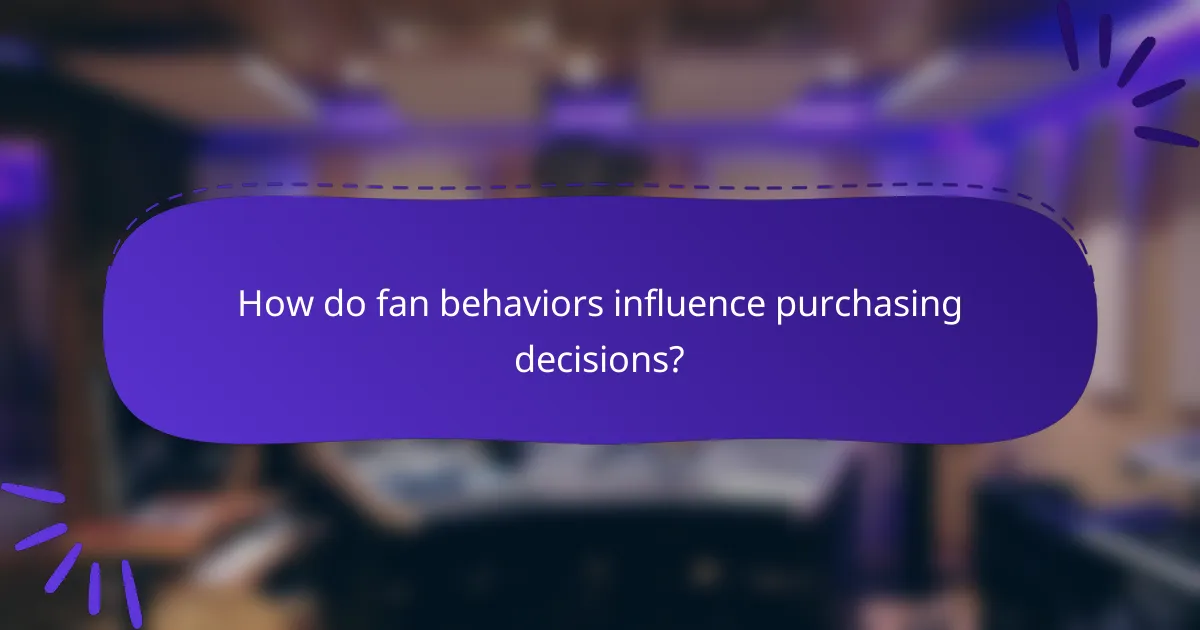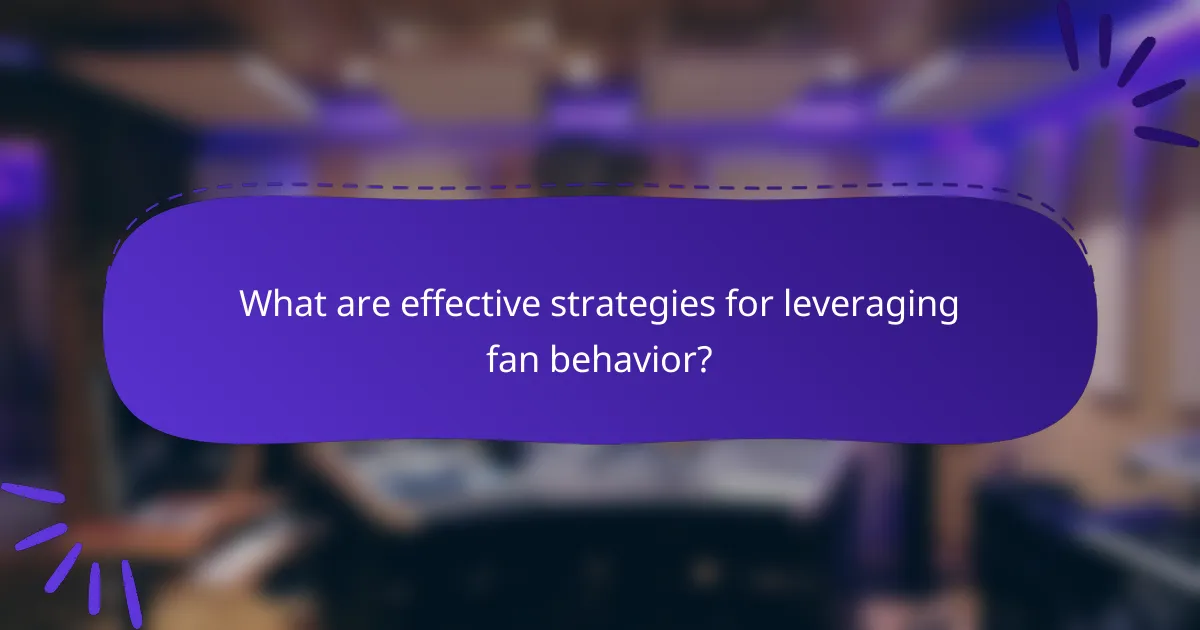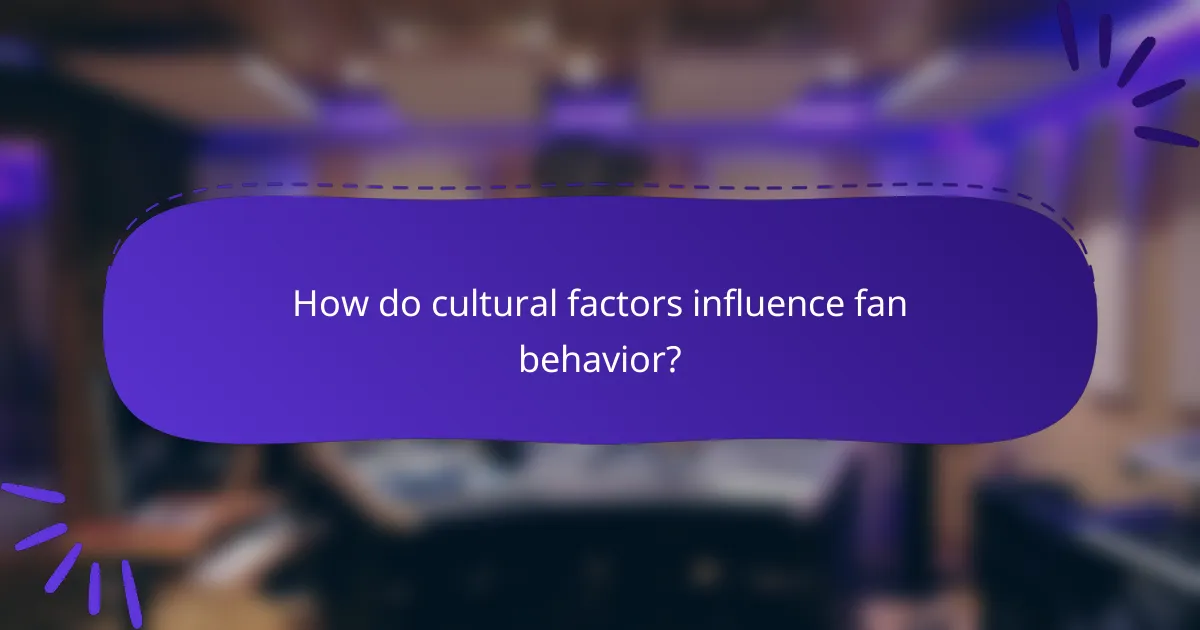In today’s digital landscape, fan behavior trends are reshaping the way businesses approach e-commerce and customer engagement. As fans seek more interactive and personalized experiences, understanding these patterns is essential for brands looking to cultivate loyalty and drive sales. By analyzing fan preferences and leveraging data-driven strategies, organizations can create meaningful connections that enhance customer satisfaction and influence purchasing decisions.

What are the latest fan behavior trends in e-commerce?
The latest fan behavior trends in e-commerce highlight a significant shift towards more interactive and personalized shopping experiences. As consumers increasingly engage with brands online, understanding these trends is crucial for businesses aiming to enhance customer satisfaction and loyalty.
Increased engagement through social media
Social media platforms are becoming vital channels for e-commerce engagement, allowing brands to connect directly with fans. This interaction often includes live shopping events, influencer collaborations, and user-generated content, which can drive sales and foster community.
Brands should actively participate in conversations on platforms like Instagram and TikTok, where visual content thrives. Engaging with fans through comments, polls, and live streams can create a sense of belonging and encourage repeat purchases.
Shift towards personalized shopping experiences
Personalization in e-commerce is increasingly important, as consumers expect tailored recommendations based on their preferences and behaviors. Utilizing data analytics, brands can offer customized product suggestions, targeted promotions, and unique shopping experiences that resonate with individual fans.
To implement personalization effectively, businesses should collect and analyze customer data responsibly, ensuring compliance with privacy regulations. Simple strategies include sending personalized emails and creating dynamic website content that adapts to user behavior.
Growth in mobile shopping
Mobile shopping continues to grow as more consumers prefer using smartphones for online purchases. This trend emphasizes the need for e-commerce sites to be mobile-friendly, ensuring quick load times and easy navigation to enhance the shopping experience.
Brands should optimize their websites for mobile devices and consider developing dedicated apps. Offering features like mobile-exclusive discounts and streamlined checkout processes can significantly improve conversion rates and customer satisfaction.

How do fan behaviors influence purchasing decisions?
Fan behaviors significantly impact purchasing decisions by shaping brand loyalty and influencing consumer choices. When fans feel a strong connection to a brand or team, they are more likely to make purchases related to that brand, whether it’s merchandise, tickets, or experiences.
Emotional connection to brands
Emotional connections to brands play a crucial role in consumer purchasing behavior. Fans who identify with a brand often develop loyalty that translates into consistent buying patterns. For example, a sports fan may choose to buy jerseys or memorabilia from their favorite team, reflecting their emotional investment.
Brands can enhance this emotional connection through storytelling and community engagement, making fans feel like they are part of something larger. This can lead to increased sales during key events, such as playoffs or championships, when emotional ties are at their peak.
Impact of influencer endorsements
Influencer endorsements can significantly sway fan purchasing decisions by leveraging the trust and admiration fans have for these figures. When a popular influencer promotes a product, it can lead to a spike in sales, especially if the product aligns with the influencer’s brand and the interests of their followers.
Brands should carefully select influencers whose values resonate with their target audience to maximize the effectiveness of endorsements. Authenticity is key; fans are more likely to purchase products that they believe are genuinely endorsed by someone they trust.
Community-driven purchasing
Community-driven purchasing occurs when fans collectively decide to buy products based on shared interests or group dynamics. This can be seen in fan clubs or online communities where members encourage each other to purchase merchandise or tickets for events.
Brands can tap into this trend by creating exclusive offers or group discounts that appeal to fan communities. Engaging with these groups through social media or events can foster a sense of belonging, further driving collective purchasing behavior.

What are effective strategies for leveraging fan behavior?
Effective strategies for leveraging fan behavior involve understanding their preferences and engagement patterns to enhance marketing efforts and build loyalty. By utilizing data analytics, creating loyalty programs, and engaging fans with interactive content, organizations can foster deeper connections and drive revenue.
Utilizing data analytics for targeted marketing
Data analytics allows organizations to gather insights on fan behavior, preferences, and engagement levels. By analyzing this data, businesses can create targeted marketing campaigns that resonate with specific segments of their audience, increasing the likelihood of conversions.
Key steps include collecting data from various sources such as social media, ticket sales, and merchandise purchases. Using tools like customer relationship management (CRM) systems can help in segmenting fans based on their interactions and preferences, enabling more personalized marketing efforts.
Creating loyalty programs
Loyalty programs incentivize fans to engage more frequently and spend more on products and services. These programs can include rewards such as discounts, exclusive merchandise, or early access to events, which encourage repeat purchases and foster a sense of belonging.
Consider implementing tiered loyalty systems where fans can unlock greater rewards as they engage more. This approach not only enhances fan retention but also provides valuable data on purchasing behavior that can inform future marketing strategies.
Engaging fans through interactive content
Interactive content, such as polls, quizzes, and live Q&A sessions, can significantly enhance fan engagement. This type of content encourages participation and provides fans with a platform to express their opinions and preferences, making them feel valued.
To maximize effectiveness, ensure that interactive content is relevant to current events or fan interests. For instance, during a sports season, quizzes about player statistics or polls on game outcomes can drive engagement and keep fans invested in the brand.

How can brands analyze fan behavior effectively?
Brands can analyze fan behavior effectively by leveraging data collection methods and analytical tools to gain insights into preferences and engagement patterns. Understanding these behaviors allows brands to tailor their marketing strategies and enhance fan experiences.
Implementing customer feedback loops
Customer feedback loops involve continuously gathering and analyzing fan input to refine products and services. Brands can use surveys, social media polls, and direct communication to collect valuable insights from fans about their experiences and preferences.
To implement effective feedback loops, brands should ensure timely responses to fan input and communicate any changes made as a result. This not only builds trust but also encourages ongoing engagement, creating a cycle of improvement and satisfaction.
Using AI-driven analytics tools
AI-driven analytics tools enable brands to process large volumes of data quickly, identifying trends and patterns in fan behavior. These tools can analyze social media interactions, purchase history, and engagement metrics to provide actionable insights.
When selecting AI tools, brands should consider factors such as ease of integration, scalability, and the ability to generate real-time reports. Utilizing these insights can help brands make informed decisions and enhance their marketing strategies to better resonate with their fan base.

What are the key metrics for measuring fan engagement?
Key metrics for measuring fan engagement include social media interaction rates and conversion rates from fan-driven campaigns. These metrics help organizations understand how effectively they connect with their audience and drive desired actions.
Social media interaction rates
Social media interaction rates gauge how actively fans engage with content across platforms like Facebook, Twitter, and Instagram. This can include likes, shares, comments, and overall reach. A high interaction rate often indicates strong fan interest and loyalty.
To calculate interaction rates, divide the total interactions by the total followers and multiply by 100 to get a percentage. For example, if a post receives 200 interactions from 1,000 followers, the interaction rate is 20%. Aim for rates above 5% to indicate healthy engagement.
Conversion rates from fan-driven campaigns
Conversion rates from fan-driven campaigns measure the percentage of fans who take a desired action, such as signing up for a newsletter or purchasing merchandise. This metric is crucial for assessing the effectiveness of marketing strategies aimed at fans.
To calculate conversion rates, divide the number of conversions by the total number of participants in the campaign, then multiply by 100. For instance, if 50 out of 1,000 fans make a purchase after a campaign, the conversion rate is 5%. Strive for conversion rates of 2-5% for successful campaigns.

How do cultural factors influence fan behavior?
Cultural factors significantly shape fan behavior by affecting preferences, engagement levels, and loyalty to brands. These influences can vary widely across different regions, leading to distinct patterns in how fans interact with sports, entertainment, and merchandise.
Regional preferences in product offerings
Regional preferences dictate the types of products that resonate with fans in different cultures. For instance, in Europe, football merchandise tends to dominate, while in the United States, American football and basketball gear are more popular. Understanding these regional tastes can help brands tailor their offerings to meet local demand.
Additionally, local customs and traditions can influence product design and marketing strategies. For example, in countries with strong national pride, limited edition items celebrating local teams may see higher sales. Brands should consider these cultural nuances when developing their product lines.
Variations in brand loyalty across cultures
Brand loyalty can vary significantly depending on cultural context. In some cultures, loyalty is driven by emotional connections and community ties, while in others, it may be influenced by price and availability. For instance, fans in Asia may show strong loyalty to local teams, whereas fans in North America might switch brands based on promotional deals.
To effectively cultivate brand loyalty, companies should engage with fans through culturally relevant marketing campaigns. This could involve local sponsorships, community events, or collaborations with popular local figures. Understanding these variations is crucial for brands aiming to build lasting relationships with their fan base.


